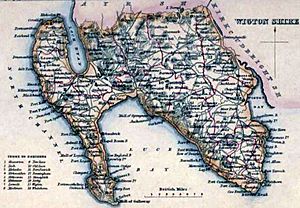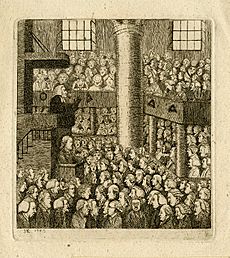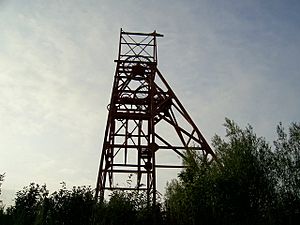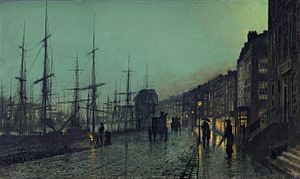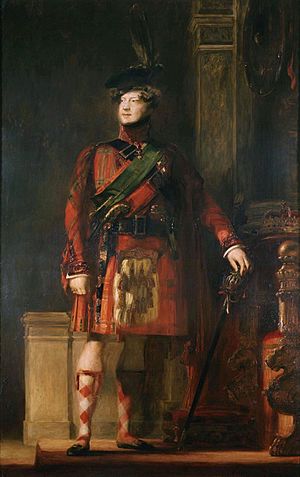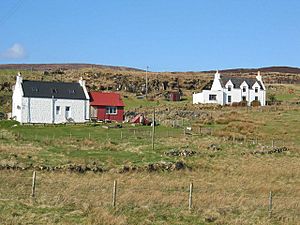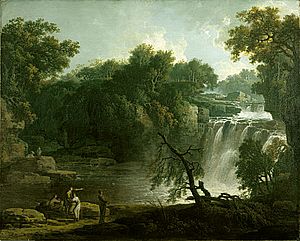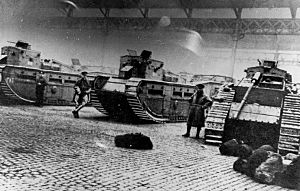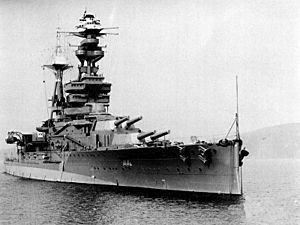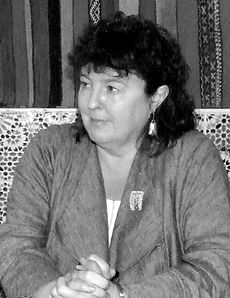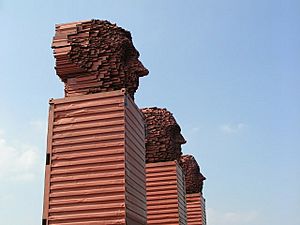Scotland in the modern era facts for kids
Scotland in the modern era, from the late 1700s to today, has been very important in the history of the United Kingdom and Europe. Questions about Scotland's place and identity have often been big topics in politics.
Scotland greatly influenced European thinking, especially during the Enlightenment. Famous Scots like economist Adam Smith and philosophers David Hume shared new ideas. Scientists like James Watt and Lord Kelvin also made huge discoveries. Scotland's economy helped the industrial revolution with its banking system, cotton, coal mining, and shipbuilding. As industries grew, many people moved from the countryside to towns, or even left Scotland entirely. Scots helped build countries like the US, Canada, Australia, and New Zealand.
In the 20th century, Scotland played a big part in both World Wars. However, its industries started to decline. This decline was very noticeable in the second half of the century. But new oil industries, technology, and service jobs helped balance this out. During this time, discussions about Scotland's place in the UK grew. The Scottish National Party became more popular. After a vote in 1999, Scotland got its own Scottish Parliament.
Contents
Scotland in the 18th and 19th Centuries
After Scotland joined with England in 1707, many Scots took on important roles. They worked in politics, government, the army, navy, trade, and in the growing British Empire. Historians note that Scots became much more involved in political life after 1746. Scotland, especially the Lowlands, became a key part of the British economy.
Politics and Government
In the late 1700s and throughout the 1800s, Scottish politics was mostly led by the Liberal Party. After the Scottish Reform Act 1832, more Scottish Members of Parliament (MPs) were elected. More middle-class people could also vote. Even so, Scottish MPs were often outnumbered by English and Welsh MPs.
Few Scots held top government jobs. However, in 1885, the job of Secretary of State for Scotland was brought back. This showed that Scottish issues were becoming more important. Later, the Earl of Rosebery became the first Scottish Liberal Prime Minister.
Towards the end of the 1800s, workers gained more power. Keir Hardie's success in an election led to the creation of the Scottish Labour Party. This party later joined the Independent Labour Party, with Hardie as its first leader.
The Scottish Enlightenment
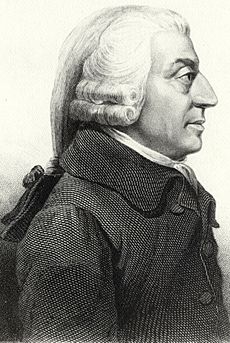
In the 1700s, the Scottish Enlightenment made Scotland a leader in new ideas in Europe. Scotland was quite poor in 1707. But it gained from free trade within the British Empire. It also had a very good university system. These two things helped Scottish thinkers question old ideas. Because Scotland had strong links with France, which was also having an Enlightenment, Scots developed a unique, practical way of thinking. The French writer Voltaire even said, "we look to Scotland for all our ideas of civilization".
One of the first big thinkers was Francis Hutcheson. He taught at the University of Glasgow. He believed that good actions bring "the greatest happiness for the greatest numbers." This idea is called utilitarianism. Later, his students David Hume and Adam Smith helped develop the scientific method. They also shaped how we think about science and religion.
Hume became a key figure in sceptical philosophy. He and other Scottish thinkers created a 'science of man'. This looked at how humans behaved in old and early cultures. It also considered how modern life shaped them. Modern sociology largely grew from this movement. Adam Smith wrote The Wealth of Nations, the first book on modern economics. It changed British economic policy and still influences talks about globalisation today.
The Scottish Enlightenment covered many fields. It included economics, science, and medicine. Important scientists were William Cullen (physician and chemist), Joseph Black (physicist and chemist), and James Hutton (the first modern geologist). Even after the main Enlightenment period, Scots continued to make huge contributions to science and literature. These included James Watt, James Clerk Maxwell, Lord Kelvin, and Sir Walter Scott.
Religion in Scotland
The 1700s and 1800s saw many changes in the Church of Scotland. These changes were often about who controlled the church and who could choose ministers. There were also disagreements between different groups within the church. Some groups left to form their own churches. For example, the First Secession in 1733 led to new churches.
In 1843, a major split happened, called the Disruption of 1843. About a third of the ministers left the Church of Scotland. They formed the Free Church of Scotland. This was mainly because they believed congregations should choose their own ministers. Later, some of these churches reunited. Most of the Free Church rejoined the Church of Scotland in 1929.
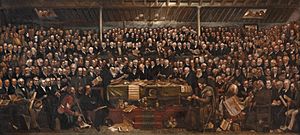
By the mid-1700s, Catholicism was only found in a few parts of Scotland, mostly in the Highlands. After the Jacobite risings, conditions for Catholics got worse. However, in 1829, Catholics gained more rights. Many Irish immigrants, especially after the famine in the 1840s, came to Scotland. They mostly settled in cities like Glasgow. This greatly increased the number of Catholics. In 1878, the Roman Catholic Church was officially re-established in Scotland.
Other Christian groups also grew in the 1800s. These included Episcopalians, Baptists, Congregationalists, and Methodists. The Salvation Army also started working in Scottish cities from 1879.
The Industrial Revolution in Scotland
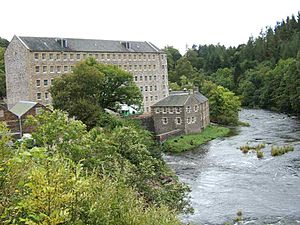
During the Industrial Revolution, Scotland became a major industrial hub of the British Empire. With no more trade taxes with England, Scottish merchants had huge opportunities. Especially with Colonial America. At first, Scotland was too poor to fully use these chances. In 1750, Scotland was still a poor farming country with 1.3 million people.
Some progress was made. Linen and cattle were sold to England. Money came from military service. Glasgow became a leader in the tobacco trade after 1740. Glasgow merchants who made money from American trade invested in other businesses. These included leather, textiles, iron, coal, and sugar. This helped Glasgow become a major industrial city after 1815. The tobacco trade stopped during the American Revolution. But trade with the West Indies grew, especially for cotton, sugar, herring, and linen.
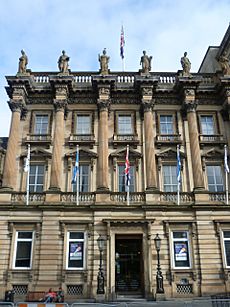
Linen was Scotland's main industry in the 1700s. It laid the groundwork for cotton, jute, and wool industries later. The British Linen Company, started in 1746, was the biggest linen company. It exported linen to England and America. This company also started lending money and became a bank. It was renamed the British Linen Bank in 1906. Scotland had a strong banking system by the end of the 1700s. There were over 400 bank branches, which was double the number in England. This flexible banking system helped Scotland's economy grow quickly in the 1800s.
From about 1790, textiles became the most important industry in west Scotland. Cotton spinning and weaving boomed until 1861. The American Civil War cut off cotton supplies. The industry never fully recovered. But by then, Scotland had developed heavy industries using its coal and iron. A new invention in 1828, the hot blast for smelting iron, changed the iron industry. Scotland became a center for engineering, shipbuilding, and making locomotives. Later in the 1800s, steel production mostly replaced iron.
Coal mining became a huge industry, growing into the 1900s. It provided fuel for homes, factories, and steam engines. By 1914, Scotland had 1 million coal miners. Miners were known for their strong sense of community and support for workers' rights.
Britain was a world leader in building railways. The first successful train line in Scotland opened in 1831. By the late 1840s, there was good passenger service. A great network of freight lines reduced the cost of shipping coal. This made Scottish products competitive across Britain. For example, railways allowed Scottish beef and milk to reach the London market.
Growth of Cities
Scotland was already one of the most urbanized (city-based) societies in Europe by 1800. The industrial area stretched across the country from southwest to northeast. By 1900, four industrial counties held 44% of the population. Glasgow and the River Clyde became a major shipbuilding center. Glasgow grew into one of the world's largest cities. It was known as "the Second City of the Empire" after London.
Shipbuilding on Clydeside (the River Clyde area) began in 1712. After 1860, Clydeside shipyards focused on steamships made of iron, then steel. These quickly replaced wooden sailing ships. Clydeside became the world's top shipbuilding center. "Clydebuilt" became a sign of quality. The shipyards built warships and famous passenger liners. Output peaked between 1900 and 1918.
The rapid industrial growth brought jobs and wealth. But housing, town planning, and public health services could not keep up. For a time, living conditions in some cities were very bad. There was overcrowding, high infant deaths, and more tuberculosis. Companies built cheap housing to attract workers from the countryside and immigrants from Ireland.
The Highlands
Historians believe the clan system in the Highlands was already changing before the Jacobite Rising of 1745 failed. After the rising, the British government passed laws to speed up these changes. They banned carrying weapons, wearing tartan, and limited the Episcopalian Church. Most of these laws were removed by the late 1700s.
Highland culture soon saw a comeback. Tartan was already used by Highland regiments in the British army. In the 1820s, during the Romantic revival, tartan and the kilt became popular among the upper classes across Europe. The international craze for tartan was boosted by the Ossian poems and Sir Walter Scott's novels. Scott's "staging" of King George IV's visit to Scotland in 1822, where the king wore tartan, led to huge demand for kilts. Clan tartans were largely defined then and became a key symbol of Scottish identity. Queen Victoria also loved the Highlands, which helped make Scotland a popular tourist spot. Her enthusiasm led to new tartan patterns like "Balmoral," named after her Balmoral Castle.
The Highlands were mostly farming areas, with only about 9% of the land good for crops. There were often famines. From the 1700s, the population grew. Highland landlords were in debt and wanted more money from their lands. They often replaced small farms with large sheep farms. This led to the eviction of tenants, known as the Highland clearances. Many people were forced to move to small plots of land called crofts. They were expected to work in fishing or kelp industries. Some chose to emigrate instead of becoming crofters.
After the Napoleonic Wars, Highland industries declined. Cattle prices fell, and the kelp industry almost disappeared. Crofting communities became common, but overcrowding continued. People relied on potatoes for food. When potato blight arrived in 1846, a severe famine followed, lasting about 10 years. Landowners helped their tenants, but a long-term solution was needed. It was cheaper for landlords to pay for tenants to emigrate. Almost 11,000 people were helped to emigrate by their landlords between 1846 and 1856. Many others paid their own way.
The unfair ownership of land remained a big issue. Poor crofters joined the evangelical Presbyterian revival after 1800. This movement was led by local preachers who criticized the rich landowners. This religious change gave crofters energy and separated them from the landlords. It helped them challenge the landlords in the 1880s through the Highland Land League. Violence started on the Isle of Skye when landlords cleared land for sheep. The government stepped in and passed the Crofters' Holdings (Scotland) Act, 1886. This law reduced rents, guaranteed land rights, and broke up large estates to provide crofts. In 1885, three Crofter candidates were elected to Parliament. They helped secure rights for Scottish smallholders.
Emigration from Scotland
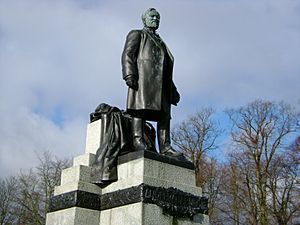
Scotland's population grew steadily in the 1800s. It went from 1.6 million in 1801 to 4.4 million in 1901. Even with growing industries, there weren't enough good jobs. So, between 1841 and 1931, about 2 million Scots moved to North America and Australia. Another 750,000 moved to England. By the 21st century, there were as many people of Scottish descent in Canada and the US as there were people living in Scotland. Scots played key roles in founding and shaping the United States, Canada, Australia, and New Zealand.
Education in Scotland
A goal from the Reformation was to have a school in every parish. This was made law in 1696. In rural areas, landowners had to provide a schoolhouse and pay a teacher. Ministers watched over the quality of education. In towns, local councils ran burgh schools. This wide network of schools led to the idea that many bright young Scots could rise up through the system. It was also believed that Scotland had higher literacy rates than other countries. However, historians now know that few boys actually rose very high. Also, literacy was not much higher than in other nations. Education in parish schools was basic, short, and not compulsory.
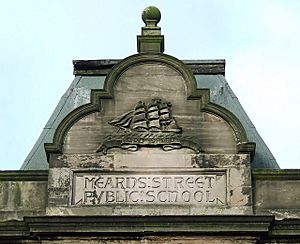
Industrial growth, city expansion, and the 1843 church split weakened the parish school system. From 1830, the state started funding school buildings. By 1872, Scotland had a system like England's. State-funded, mostly free schools were run by local school boards. Education became compulsory for ages five to thirteen. Many new schools were built. Larger city school boards set up "higher grade" (secondary) schools. The Scottish Education Department introduced a Leaving Certificate Examination in 1888. This set national standards for secondary education. In 1890, school fees were removed. This created a state-funded system of free basic education.
Scotland's five universities had focused on training for church and law. After the troubles of the 1600s, they recovered. They offered a good education in economics and science. This helped them become major centers of Enlightenment thinking. In the mid-1800s, the University of Glasgow became a leader in British higher education. It educated young people from cities and businesses, as well as the upper class. It prepared students for careers in government, law, medicine, education, and the church. A smaller group studied science and engineering. Scottish universities started admitting women from 1892.
Scottish Literature
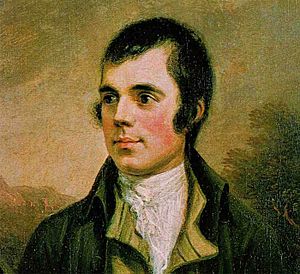
Even as Scotland adopted English culture, its literature developed a unique national identity. It also gained international fame. Allan Ramsay (1686–1758) helped renew interest in older Scottish literature. He also led the trend for pastoral poetry. James Macpherson was the first Scottish poet to become famous worldwide. He claimed to have found poems by Ossian. His translations became very popular. They were seen as a Celtic version of the Classical epics. Fingal (1762) was quickly translated into many European languages. It influenced the Romantic movement in Europe. Later, it became clear that the poems were not direct translations. They were adaptations to suit his audience.
Robert Burns and Walter Scott were greatly influenced by the Ossian poems. Burns, a poet from Ayrshire, is seen as Scotland's national poet. He was a key figure in the Romantic movement. Burns wrote his own poems and songs. He also collected and adapted folk songs from Scotland. His song "Auld Lang Syne" is sung at Hogmanay (New Year's Eve). "Scots Wha Hae" was an unofficial national anthem for a long time. Scott started as a poet and collected Scottish ballads. His first novel, Waverley (1814), is often called the first historical novel. His successful career helped define and popularize Scottish culture.
In the late 1800s, several Scottish-born authors became internationally famous. Robert Louis Stevenson wrote Strange Case of Dr Jekyll and Mr Hyde (1886). He also helped develop historical adventure stories like Kidnapped and Treasure Island. Arthur Conan Doyle's Sherlock Holmes stories helped create detective fiction. The "kailyard tradition" brought back fantasy and folklore. This can be seen in the work of J. M. Barrie, famous for Peter Pan, and George MacDonald, whose works like Phantasies helped create the fantasy genre.
Art and Architecture
Scotland produced some very important British artists and architects during this time. Many Scottish artists traveled to Italy in the 1700s. Early painters like the Norie family painted Scottish landscapes that looked like Italian and Dutch scenes. Later artists like Allan Ramsay and Gavin Hamilton became important European artists. They were influenced by Neoclassicism.
The romantic view of the Highlands in the late 1700s greatly affected Scottish art. This can be seen in the work of Jacob More and Alexander Runciman. The next generation of artists included Henry Raeburn (portraits) and Alexander Nasmyth (landscapes). The Royal Scottish Academy of Art was founded in 1826. This made it easier for artists to show and sell their work. David Wilkie was one of the most successful portrait painters. Highland landscape painting continued with artists like Horatio McCulloch. The Glasgow School developed in the late 1800s. It blended influences like the Celtic Revival and Arts and Crafts Movement. This style became popular in Europe and helped define Art Nouveau. Key members included architect Charles Rennie Mackintosh and his wife, artist Margaret MacDonald.
Scotland also had important architects in the 1700s. These included Colen Campbell and Robert Adam. They often used classical styles. Edinburgh's New Town was built with this classical style. Its rectangular blocks and open squares earned Edinburgh the nickname "The Athens of the North." Many Scottish architects worked in England, where they greatly influenced Georgian architecture.
Scotland in the 20th Century
In the 1900s, Scotland played a big part in Britain's efforts in two World Wars. But it also faced economic decline. This only started to change in the 1970s with North Sea oil and gas. New technologies and service industries also grew. This period also saw a stronger sense of Scottish culture and politics. This led to the creation of a separate Scottish Parliament in 1999.
Before and During the World Wars
Before World War I, Scotland's fishing industry was thriving. Scottish catches dominated Europe's herring trade. This was thanks to new steam-powered boats. However, the Scottish economy generally struggled, leading to unemployment.
Scotland played a major role in the First World War. It provided many soldiers, ships, machinery, and food. With a population of 4.8 million in 1911, Scotland sent 690,000 men to war. About 74,000 died, and 150,000 were seriously wounded. Scots made up 15% of the British armed forces and 20% of the deaths. Clydeside shipyards became key centers for shipbuilding and arms production. In Glasgow, poor working and living conditions led to unrest.
Between the World Wars
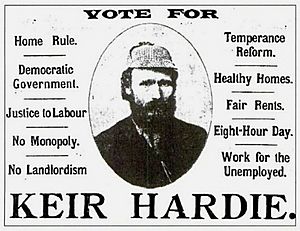
After World War I, the Liberal Party declined. The Labour Party became the main party for working-class people in Scotland. The Unionists (Conservatives) gained support from the middle classes. New nationalist groups emerged, like the National Party of Scotland in 1928. They merged to form the Scottish National Party (SNP) in 1934. Their goal was an independent Scotland, but they had little success at first.
The years between the wars were tough economically. There was high unemployment. Scotland relied heavily on old heavy industries and mining. The shipbuilding industry, which had grown during the war, shrank greatly. A serious economic depression hit by 1922. It didn't fully recover until 1939. Skilled workers were hit hard.
A radical movement grew on Red Clydeside. In January 1919, the British Government sent tanks and soldiers to Glasgow. This was due to fears of a revolutionary uprising. The industrial areas, once Liberal strongholds, switched to Labour by 1922. Women were active in organizing around housing and rent issues.
Many young people continued to leave Scotland. About 400,000 Scots, 10% of the population, left between 1921 and 1931. Economic problems were one reason. But also, people wanted travel and adventure. There were better job opportunities abroad. Family and friends who had already left encouraged others to follow.
Scottish Renaissance in Arts
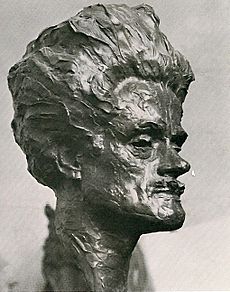
In the early 1900s, Scottish literature and art saw a new burst of energy. This was influenced by modernism and growing nationalism. It was called the Scottish Renaissance. The main figure was Hugh MacDiarmid (Christopher Murray Grieve). Other writers like Neil Gunn and Nan Shepherd explored Scottish identity. They rejected old-fashioned views and looked at social and political issues.
In art, the Scottish Colourists emerged in the 1920s. These included John Duncan Fergusson and Francis Cadell. They were influenced by the Fauvists. They are seen as the first Scottish modern artists. They brought Post-Impressionism to Scotland. In the years between the wars, artists like Stanley Cursiter and William Johnstone brought modernism into their work. Johnstone also helped develop the idea of a Scottish Renaissance.
Second World War and After
The Second World War brought new prosperity, even with city bombings. Robert Watson-Watt invented radar, which was vital in the Battle of Britain. Scapa Flow in Orkney was an important Royal Navy base. Shipyards and factories in Glasgow played a key part in the war effort. They suffered attacks from the Luftwaffe. Scotland was also important in the Battle of the North Atlantic. Shetland's closeness to occupied Norway led to the Shetland Bus. Fishing boats helped Norwegians escape the Nazis.
Scottish industry recovered from the depression. It expanded greatly, employing many men and women. Shipyards were very busy. Many smaller industries made machinery for British bombers, tanks, and warships. Farming also did well. Wages rose, and unemployment disappeared. Better income and fair food distribution through rationing improved health. The average height of 13-year-olds in Glasgow increased by 2 inches.
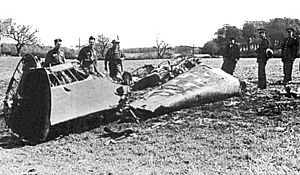
Prime Minister Winston Churchill appointed Tom Johnston as Secretary of State for Scotland in 1941. Johnston was a very important figure in Scottish politics. He launched many projects to help Scotland. He brought 700 businesses and 90,000 new jobs to Scotland. He set up committees to deal with social and economic problems. He also created a system for hydro electricity in the Highlands. Johnston, a supporter of Home Rule, convinced Churchill to give some power to Scotland.
Scotland Today: 1946–Present
Politics After the War
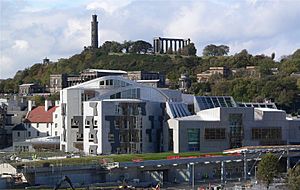
After World War II, the Labour Party usually won most Scottish parliamentary seats. Support from Scotland was very important for Labour's success in UK elections. The number of Scottish seats held by the Unionists (Conservatives from 1965) steadily dropped. It fell to zero in 1997.
The Scottish National Party (SNP) gained its first seat in 1945. It became a nationally important party in the 1970s. However, a vote on devolution in 1979 failed. The SNP then declined in the 1980s. In 1989, the Conservative government introduced the Community Charge (Poll Tax) in Scotland a year before the rest of the UK. This led to a growing movement for Scotland to control its own affairs.
On 11 September 1997, the 700th anniversary of the Battle of Stirling Bridge, the Labour government held another vote on devolution. This time, it passed. This led to the creation of a devolved Scottish Parliament in 1999. The new Scottish Parliament Building opened in Edinburgh in 2004. The SNP had great success in the 2015 UK General Election. They also became the official opposition in the Scottish Parliament in 1999. They formed a minority government in 2007 and a majority government in 2011.
Economy After the War
After World War II, Scotland's economy got worse. This was due to competition from other countries and old industries. This started to change in the 1970s. The discovery of North Sea oil and gas helped a lot. Scotland also moved towards a more service-based economy.
The discovery of the huge Forties oilfield in 1970 meant Scotland would become a major oil producer. Oil production began in 1975. Traditional heavy industries rapidly declined in the 1970s and 1980s. Many closed down completely. A new service economy emerged. This included a growing financial services industry. It also included electronics manufacturing in an area known as Silicon Glen.
Religion in the 20th Century
In the 1900s, new Christian groups appeared. But after World War II, church attendance steadily declined for most groups. Many churches closed. In the 2011 census, 53.8% of Scots identified as Christian. The Church of Scotland is the largest Christian group. The Roman Catholic Church is also important, especially in west-central Scotland and the Highlands.
In recent years, other religions have grown in Scotland. This is mainly due to immigration. In the 2011 census, Islam was 1.4% of the population. Hinduism, Buddhism, and Sikhism also have a presence. Many people (43.6% in 2011) said they had no religion or did not state one.
Education in the 20th Century
The Scottish education system changed a lot in the 1900s. In 1918, Roman Catholic schools joined the system. But they kept their religious character. The school leaving age was raised to 14 in 1901. It was eventually raised to 16 in 1973. Secondary education grew a lot, especially for girls.
New qualifications were created. The Leaving Certificate was replaced by the Scottish Certificate of Education Ordinary Grade ('O-Grade') and Higher Grade ('Higher') in 1962. These became the basic qualifications for university. The education system became more focused on Scotland. Its headquarters moved to Edinburgh in 1939. After devolution in 1999, the new Scottish Executive took over education. One big change was ending student tuition fees in 1999. Instead, Scotland kept a system of student grants based on need.
New Scottish Literature
After World War II, some writers like Robert Garioch wrote in Scots. Others, like Norman MacCaig, focused on English poetry. George Mackay Brown and Iain Crichton Smith wrote poetry and stories influenced by their island homes. The Glaswegian poet Edwin Morgan was known for translating works from many languages. He became the first Scots Makar (official national poet) in 2004.
Many major Scottish novelists after the war lived outside Scotland. But they often wrote about Scottish themes. Examples include Muriel Spark's The Prime of Miss Jean Brodie (1961). Popular action novels by Alistair MacLean and historical fiction by Dorothy Dunnett were also successful. A younger generation of novelists emerged in the 1960s and 1970s, including William McIlvanney.
From the 1980s, Scottish literature had another big revival. This was linked to a group of Glasgow writers. Important writers included James Kelman, Alasdair Gray, and Liz Lochhead. In the 1990s, famous Scottish novels like Irvine Welsh's Trainspotting (1993) and Kelman's How Late It Was, How Late (1994) appeared. These books often explored difficult experiences and used strong, local language.
Scottish crime fiction also grew hugely. Successful novelists include Val McDermid and Ian Rankin, famous for his Inspector Rebus novels. This period also saw new Scottish poets become leading figures in the UK. These included Don Paterson and Carol Ann Duffy. Glasgow-born Carol Ann Duffy became Poet Laureate in 2009. She was the first woman, Scot, and openly gay poet to hold the post.
Modern Scottish Art
Important post-war artists included Anne Redpath, known for her everyday object paintings. Alan Davie was influenced by jazz and Zen Buddhism. Sculptor Eduardo Paolozzi was a pioneer of pop art. He created many works that explored fantasy and the modern world.
John Bellany and Alexander Moffat were leading Scottish thinkers from the 1960s. They focused on coastal communities and portraits. Artists linked to the Glasgow School of Art are sometimes called the "new Glasgow Boys." These include Steven Campbell and Peter Howson. Their art often looks like comic books and comments on society. Since the 1990s, Jack Vettriano has been the most commercially successful artist. His painting The Singing Butler (1992) is very famous.
|


